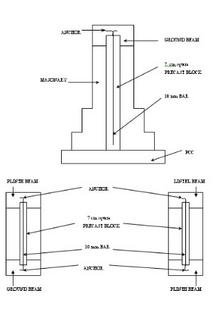கடலை வசக்குதல்
கடந்த நூற்றாண்டுகளில் உயர்சாதியினர் கடற்பயணம் மேற்கொள்வது அவர்களது சாதிநீக்கத்தில் முடிந்துள்ளது. காந்தியும் இராமானுஜமும் இத்தடையைப் புறங்காண வேண்டியிருந்தது. இச்சூழலில் நம் நாட்டில் கடல் வாணிகம் செழித்து வளர முடியாத நிலையால் ஐரோப்பிய வாணிகர்களுக்கு நம் நாட்டினுள் நுழைய எளிதான வழியை அழைத்துக் கொடுத்து அவர்கள் நம் ஆண்டைகள் ஆக முடிந்தது. நம் கண்ணோட்டங்களை மாற்றி விலைமதிக்க முடியாத நம் கடற்கரைக்கு உரிய மதிப்பை அளிக்க வேண்டிய ஒரு வாய்ப்பை வீங்கலை வழங்கியுள்ளது.
அண்மைக் கடந்த காலத்தில் கடற்கரையிலிருந்து 500 மீட்டர்கள் எல்லைக்குள் கட்டுமானங்களைத் தடைசெய்யும் ஆணையொன்றைப் பிறப்பிக்க இந்திய அரசை இசைவிக்க சூழியலாளரால் முடிந்தது. அந்த எல்லை பெருந்தொழிற் துறையினரின் நெருக்குதலால் 100 மீ ஆகக் குறைக்கப்பட்டு உச்சநீதிமன்றத் தலையீட்டினால் 200 மீ ஆக்கப்பட்டுள்ளது. அரசியலாளரின் துணையுடன் சில இடங்களில் கடலோரத் தடைச் சுவர்கள் கட்டுவதைக் கூட மீனவர்கள் தடுத்துள்ளனர். அங்கெல்லாம் ஓதம் மற்றும் பருவக்காற்றின் அலைகள் முட்டும் இடங்களில் வீடுகளைக் கட்டியுள்ளனர்.
கடலுக்கு இயற்கை அரணாகிய தேரி என்று குமரி மாவட்டத்தில் வழங்கப்படும் மணற்குன்றுகளை, அருமண்களுக்காகக் கச்சாவாக நேரடியாகவும் பிரித்தெடுத்தும் ஏற்றுமதி செய்ய அகற்றியதும் அவ்விடங்களில் மக்கள் குடியேறியதும் அங்கு வாழ்ந்த மக்களை வீங்கலை முன் செயலற்றவர்களாக்கி விட்டது, இப்போது கரையோர மக்களின் கண்ணோட்டத்தை வீங்கலை மாற்றியுள்ளது. கடற்கரையிலிருந்து விலகியிருக்க அவர்கள் விரும்புகிறார்கள். ஆனால் பல லட்சக்கணக்கான தங்கள் கட்டுமரங்கள், மீன்பிடி வலைகள், பிற மீன்பிடி தளவாடங்களின் பாதுகாப்பு குறித்த கவலை அவர்களை வாட்டுகிறது.
மனிதன் புனைந்த மிகப்பழைய கடல் மிதவைப் பொருள் கட்டுமரம். ஒருவர் அல்லது இருவர் மட்டும் பயன்படுத்தத்தக்க இந்த மிதவைகள் வீங்கலையின் இரக்கமற்ற கரங்களில் கொடிய ஏவுகணைகள் போல் செயற்பட்டு மனித உயிர்களையும் கட்டிடங்களையும் சொத்துகளையும் அழிப்பதில் பெரும்பங்காற்றியுள்ளன. கட்டுமரங்களை அகற்றி விட்டு படகுகள், பிற மீன்பிடி கலன்களைப் பயன்பாட்டுக்குக் கொண்டு வந்து இப்போது கட்டுமரத்தைப் பயன்படுத்துவோரை அவர்கள் வயதுக்கும் கல்விக்கும் ஏற்ப மீன்பிடிப்பு தொடர்பான தொழில்களில் திருப்பிவிட வேண்டிய காலம் கனிந்து விட்டது. இந்த இலக்கை எய்த பின்வரும் நடவடிக்கைகள் இன்றியமையாதவை.
1. தமிழ்நாட்டின் கடற்கரை நெடுகிலும் தேரிகளை மீட்டு அதன் முகட்டில் ஒரு நால்வழிச் சாலையை அமைத்து தேரியின் இரு சாய்வுகளிலும் தென்னை, பனை, தாழை, ஈந்து போன்ற பனைக்குடும்ப மரங்களையும் செடி கொடிகளையும் விறகுக்கோ, தடிக்கோ அல்லாத பிற மரங்களையும் வளர்த்தல். தேரிக்கும் உள்நாட்டு நாவிகக் கால்வாய்க்கும் இடையிலுள்ள சமநிலத்தில் தடிக்குரிய மரங்களை வளர்த்தல்.
2. கடற்கரையை அணைத்து, கன்னியாகுமரி முதல் கொச்சி வரையும் விசாகப்பட்டினத்திலிருந்து நாகப்பட்டினம் வரையிலும் சென்ற, முறையே ஏ.வி.எம். கால்வாய். பக்கிங்காம் கால்வாய் ஆகியவற்றில் பெரும்பான்மைப் பகுதி தூர்ந்து போயுள்ள நிலையில் அவற்றை முழுமையாக மீட்டல். கடலினுள் நேரடியாகக் கழிமுகங்களைக் கொண்ட ஆறுகளினுள் வழியாமல் இடைப்பட்ட நிலப்பரப்புகளிலிருந்து கடல் நோக்கி வரும் மழைநீரை இக்கால்வாய்களினுள் இயற்கையான அல்லது தோண்டிய காயல்களின் ஊடாகப் பாயவிடுதல்.
3, ஆறுகளின் கழிமுகங்களில் பொருள் போக்குவரத்து வசதியுடன் கூடிய மீன்பிடி துறைமுகங்களை அமைத்தல். தேரி முகட்டில் ஓடும் சாலையை உயர்ந்தவையும் இயன்றவரை அகன்ற இடைவெளிகளில் அமைத்தவையுமான தூண்களின் மீதமைந்த பாலங்களால் இந்த ஆறுகளைக் கடக்க விடுதல்.
4, இந்த இயற்கைக் கழிமுகங்கள் நீண்ட தொலைவுகளில் இருந்தால் இடையில் பொருத்தமான இடங்களில் சின்னஞ்சிறு மீன்பிடி துறைமுகங்களை அமைத்தல்.
இந்த ஏற்பாடுகளைச் செய்தால் மீனவர்கள் கடற்கரையிலிருந்து 500மீ தொலைவில் மட்டுமல்ல, அதனையும் தாண்டி. துறைமுகத்திலுள்ள தங்கள் வேலைக்களத்துக்கு தொல்லையின்றி வந்து செல்லத்தக்க தொலைவில் தங்களது குடியிருப்புகளை அமைத்துக் கொள்வதில் எந்தத் தடையும் இருக்காது.
குடியிருப்புகள் கடற்கரையிலிருந்து 500மீட்டக்கு அப்பால் இருக்க வேண்டும். அங்கும் வீங்கலையின் தாக்குதலிலிருந்து பாதுகாப்பானது என்று வல்லுநர்கள் நிறுவும் மட்டம் கிடைக்கவில்லையாயின் குடியிருப்புகளைத் தூண்களின் மூலம் அம்மட்டத்துக்கு மேல் உயர்த்திக் கட்ட வேண்டும். அடுக்குமாடிக் குடியிருப்புகள் விரும்பத் தக்கவை. ஆனால் மக்கள் அதற்கு இப்போது ஆயத்தமாகவில்லை. மீன்பிடி துறைமுகங்களில் உள்கூட்டமைப்புகள் முழுமையடையும் போது மீனவர்கள் உள்நாட்டினுள் சென்று அடுக்குமாடிக் குடியிருப்புகளில் வாழ முன்வருவர். எனவே இப்போது கட்டப்பட இருக்கிற நிலையான குடியிருப்புகள் மீன்பிடிக்கும் மக்களைப் பொறுத்தவரை தற்காலிகமானவையே. அனைத்துடனும் சேர்ந்து, பெரும் கப்பல்கள் எதிரெதிராகச் செல்லுமளவுக்கு அகலமும் ஆழமும் கொண்ட ஒரு கடல் வாய்க்காலையும் தோண்ட வேண்டும். குமரிமாவட்ட மீனவர் “கப்பலோடை” என்று வழங்குகின்றனர். இத்தகைய ஒரு கப்பலோடை குமரிமுனைக்குத் தெற்கில் இருப்பதாகத் தோன்றுகிறது. அது தேரி உள்நாட்டுக் கடற்கரையோர நாவிகக் கால்வாய் ஆகியவற்றுடன் சேர்ந்து எதிர்காலத்தில் வரக்கூடிய எந்தவொரு வீங்கலையும் மக்களை அடையும் முன் அது சுமந்து வரும் பேராற்றலை அழிப்பதில் பங்கு பெறும்.
எனவே நிலையான குடியிருப்புகள், மீன்பிடி துறைமுகக் கட்டமைப்புகள், உள்நாட்டு நாவிகக் கால்வாய், தேரிகள், கடற்கால்வாய் ஆகியவற்றைத் திட்டமிடும் நடைமுறையை ஒரே நேரத்தில் தொடங்க வேண்டும்.



